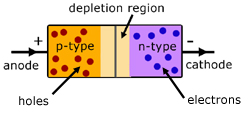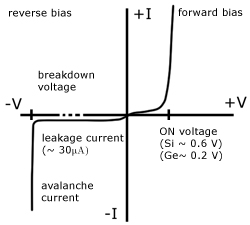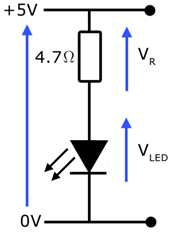AQA Physics Unit 1 PHYA1 20th May 2013
Scroll to see replies
Original post by stalker47
when you increase the resistance, current increases but voltage decreases.
hello thanks for the reply but does this rule apply to every component like the wire reister bulb etc? Thanks
Original post by sceezy
HEY, can someone help me with June 2012 question 5(a) (the 6 marker)
I can't even find it in my text book.
PLEASE!!!!!
I can't even find it in my text book.
PLEASE!!!!!
The mark scheme has the points you need to make ?
power supply connected to oscilloscope input
• time base initially switched off
• y gain adjusted to get as long a line as possible
• length of line used to find peak to peak voltage
• rms voltage found
• time base switched on and adjusted to get several
cycles on the screen
• use the time base setting to find period
• use period to find frequency
• compare vales with stated values
I think giving any 6 of these points will get you full marks (or maybe even 5 of the points), considering you have written it well

Did you mean you haven't learn about oscilloscopes ? Like how they work, uses & set-up

Original post by ak395
I've attached the answers to all the long questions from june 2009 onwards 

That was really useful, thank you! xD
I was just about to sort out a list myself..saved me a lot of time!

Original post by g4adaffi
Please someone can you explain to me what happens to the voltage and current as resistance increases in diffrent components including wires thanks and sorry for the caps.
LOL sorry! I mixed up the last reply. Here is the answer. Increasing the resistance decreases the current as increase in resistance makes it harder for current to pass through. The voltage in the circuit will remain same but in components, the voltage drop will be reduced across each existing resistor. is that ok? I will answer more question later. I am taking a break. Hope I answered your question.
(edited 10 years ago)
Original post by StalkeR47
When you increase the resistance, current increases but voltage decreases.
How can this be, if you increase resistance you would decrease current as more collisions taking place. Voltage would then increase.
Posted from TSR Mobile
Original post by Jimmy20002012
How can this be, if you increase resistance you would decrease current as more collisions taking place. Voltage would then increase.
Posted from TSR Mobile
Posted from TSR Mobile
Yes Jimmy I was wrong. I have replied to that guy again. LOL I mixed up. Check my post above yours.... I am really hungry so I cannot concentrate. Need to get some food.
Original post by StalkeR47
LOL Jimmy! Are you now clear on diodes? 

Yes I am now clear on diodes, thanks for the help

Posted from TSR Mobile
I'm really confident on quantum physics; can't say much for electricity though...
Any key points that i may really need to know etc...
Thanks in advance...

Any key points that i may really need to know etc...
Thanks in advance...
Original post by jimmy20002012
how can this be, if you increase resistance you would decrease current as more collisions taking place. Voltage would then increase.
posted from tsr mobile
posted from tsr mobile
ah thank you for clarifying this ; but i have a question: If the resistance decreases would the current increase and voltage decrease i.e the opposite of increasing resistance? Thanks
Original post by Jimmy20002012
How can this be, if you increase resistance you would decrease current as more collisions taking place. Voltage would then increase.
Posted from TSR Mobile
Posted from TSR Mobile
He might have been talking about Semi-conductors
Original post by x-Sophie-x
That was really useful, thank you! xD
I was just about to sort out a list myself..saved me a lot of time!
I was just about to sort out a list myself..saved me a lot of time!

Thats ok
 You can do one for the older papers and share with me if you want
You can do one for the older papers and share with me if you want 
Original post by milkybarkid22
I'm really confident on quantum physics; can't say much for electricity though...
Any key points that i may really need to know etc...
Thanks in advance...

Any key points that i may really need to know etc...
Thanks in advance...
Lol nice name milkybarkid.... I am in exact same position as you. I am fantastic with quantum and particle physics not but much with electricity. I have just asked on of my friend for the notes on physics electricity. My friend sent me these note and I will like to share these with everyone! http://s1195.photobucket.com/user/porterhouse7/library/Yahho%20Q%20and%20A/AQA%20unit%201?sort=2&page=1

Original post by g4adaffi
ah thank you for clarifying this ; but i have a question: If the resistance decreases would the current increase and voltage decrease i.e the opposite of increasing resistance? Thanks
If the resistance decreases, yes the current will increase.. since V=IR, you can argue that the voltage will remain same. ANY MORE QUESTIONS???
Original post by Jimmy20002012
Jimmy! Anymore questions?

Original post by StalkeR47
Jimmy! Anymore questions?

Okay right I am getting sooo confused with that diode question, must be so annyoting for you. Could you just summarise everything and how to answer questions like these. So sorry

Anything I can help you with?
Posted from TSR Mobile
Original post by Jimmy20002012
Okay right I am getting sooo confused with that diode question, must be so annyoting for you. Could you just summarise everything and how to answer questions like these. So sorry 
Anything I can help you with?
Posted from TSR Mobile

Anything I can help you with?
Posted from TSR Mobile
http://dl.dropboxusercontent.com/u/9848955/Revision%20Notes/Physics%20AS/Unit%201/Physics%20AS%20-%20Unit%201%20-%20Revision%20Notes.pdf You will find diode properties in this pdf file.
Original post by Jimmy20002012
Okay right I am getting sooo confused with that diode question, must be so annyoting for you. Could you just summarise everything and how to answer questions like these. So sorry 
Anything I can help you with?
Posted from TSR Mobile

Anything I can help you with?
Posted from TSR Mobile
Light Emitting Diode (LED)
An LED is essentially a modified junction diode (or p-n diode) so that it gives out light when current flows through it.
Junction diodes are made from two types of semiconductor material, which have been 'doped' to alter their properties.
[INDENT]p-type: rich in charge carriers called 'holes' (missing electrons)
n-type: rich in free electrons
[/INDENT]
However, when a p.d. is applied, with n-type '-' and p-type '+' (called forward biased), a current flows. This current is made up of free electrons moving across to the '+' terminal and holes moving towards the '-' terminal.
When the polarity is reversed(reverse bias), with n-type made '+' and p-type made '-' , no current flows. So we have a device that only allows current to flow in one direction.

The bottom left quadrant shows what happens when the diode is reverse biased ('+' contact connected to '-' supply and vice versa). Notice for increasing p.d. there is a constant 'leakage current' . This is very small, being of the order of micro-amps. There comes a point when the p.d. is so high that 'breakdown' occurs. A large current passes and the diode is destroyed.
it is essential in LED circuits that the exact p.d. falls across the device. If the p.d. is too high the LED will allow too much current to flow through it. The result will be overheating and failure.
To avoid this, an LED always has a 'limiting resistor' placed in series to limit the current. The level of current designed for is just enough to trigger light from the device.

[INDENT]i) the max. LED current required is 100mA
ii) the forward LED voltage is 0.65V
iii)the supply p.d. is 5V
[/INDENT]If 0.65V falls across the LED, then 4.35V must fall across the limiting resistor.
The current through both the LED and the limiting resistor is 100mA.
Therefore the limiting resistance R is given by R = V/I .
R = 4.35/0.1 = 43.5 Ω
Original post by StalkeR47

Example: Find the limiting resistor for an LED, where:i) the max. LED current required is 100mA
ii) the forward LED voltage is 0.65V
iii)the supply p.d. is 5V
If 0.65V falls across the LED, then 4.35V must fall across the limiting resistor.
The current through both the LED and the limiting resistor is 100mA.
Therefore the limiting resistance R is given by R = V/I .

Example: Find the limiting resistor for an LED, where:i) the max. LED current required is 100mA
ii) the forward LED voltage is 0.65V
iii)the supply p.d. is 5V
If 0.65V falls across the LED, then 4.35V must fall across the limiting resistor.
The current through both the LED and the limiting resistor is 100mA.
Therefore the limiting resistance R is given by R = V/I .
R = 4.35/0.1 = 43.5 Ω
Great post, thank you !

Just to confirm, the information in bold is provided in the question right ? Silly question I know
 They looked like answers. Also why in the diagram is the resistor 4.7 ohms ?
They looked like answers. Also why in the diagram is the resistor 4.7 ohms ?  Or is that no related to the question, thanks again
Or is that no related to the question, thanks againOriginal post by posthumus
Great post, thank you ! 
Just to confirm, the information in bold is provided in the question right ? Silly question I know They looked like answers. Also why in the diagram is the resistor 4.7 ohms ?
They looked like answers. Also why in the diagram is the resistor 4.7 ohms ?  Or is that no related to the question, thanks again
Or is that no related to the question, thanks again

Just to confirm, the information in bold is provided in the question right ? Silly question I know
 They looked like answers. Also why in the diagram is the resistor 4.7 ohms ?
They looked like answers. Also why in the diagram is the resistor 4.7 ohms ?  Or is that no related to the question, thanks again
Or is that no related to the question, thanks againBold writing is the question lol. And yes, 4.7 is related to the question. Hey, I am just doing a question on diode. I will post the my question and answer as attachment for you!
Quick Reply
Related discussions
- A-level Exam Discussions 2024
- GCSE Exam Discussions 2024
- A Level Exam Discussions 2023
- GCSE Exam Discussions 2023
- GCSE 2023 Grade Boundaries (All Exam Boards)
- Over 500 questions on AQA Bio Unit 4 + Current Spec and old Spec papers + MS!
- GCSE AQA Physics Paper 1 and 2 Revision and Study Chat
- btec applied science extended certificate aqa
- Oxford AQA International A-Level past papers
- IAL repeats cash in.
- Business BTEC Level 3 Extended Diploma
- GCSE Biology Study Group 2022-2023
- AQA A Level Economics Paper 2 (7136/2) - 20th May 2024 [Exam Chat]
- AQA GCSE Physics Paper 1 (Higher Tier triple) 8463/1H - 22nd May 2024 [Exam Chat]
- a level study : BLOG
- AQA A Level Sociology Paper 1 (7192/1) - 20th May 2024 [Exam Chat]
- ⭐niamhcheesecake's Yr 11 journal: help me conquer Gcse's :(( ⭐
- AS/A Level Chemistry Study Group 2023/2024
- How many GCSEs are you getting?
- AQA GCSE Physics Paper 1 (Higher Tier triple) 8463/1H - 25th May 2023 [Exam Chat]
Latest
Trending
Last reply 11 hours ago
AQA A-level Physics Paper 1 (7408/1) - 24th May 2024 [Exam Chat]Last reply 1 day ago
AQA GCSE Physics Paper 1 (Higher Tier triple) 8463/1H - 22nd May 2024 [Exam Chat]Last reply 1 week ago
AQA GCSE Physics Paper 1 (Higher Combined) 8464/1H - 22nd May 2024 [Exam Chat]Posted 2 weeks ago
AQA GCSE Physics Paper 2 (Higher Tier triple) 8463/2H - 14th June 2024 [Exam Chat]Last reply 3 weeks ago
OCR A A-level Physics Paper 1 Modelling Physics (H556/01) - 24th May 2024 [Exam Chat]Last reply 1 month ago
AQA A-level Physics Paper 2 (7408/2) - 9th June 2023 [Exam Chat]Last reply 2 months ago
Edexcel A Level Physics Paper 3: 9PH0 03 - 15th June 2023 [Exam Chat]Last reply 3 months ago
AQA A-level Physics Paper 1 (7408/1) - 24th May 2023 [Exam Chat]Physics Exams
1190
Last reply 4 months ago
Edexcel GCSE Physics Paper 1 Higher Combined 1SC0 1PH - 25th May 2023 [Exam Chat]Last reply 5 months ago
Edexcel GCSE Physics Paper 1 Higher Tier Triple 1PH0 1H - 25th May 2023 [Exam Chat]Last reply 5 months ago
AQA A-level Physics Paper 3 (7408/3) - 15th June 2023 [Exam Chat]Last reply 10 months ago
Edexcel GCSE Physics Paper 2 Higher Tier Triple 1PH0 2H - 16th June 2023 [Exam Chat]Last reply 10 months ago
OCR B A-level Physics Paper 3 Advancing Physics (H557/03) - 15th Jun 2023 [Exam Chat]Last reply 10 months ago
OCR GCSE Physics A Paper 4 Higher Tier (J249/04) - 16th June 2023 [Exam Chat]Trending
Last reply 11 hours ago
AQA A-level Physics Paper 1 (7408/1) - 24th May 2024 [Exam Chat]Last reply 1 day ago
AQA GCSE Physics Paper 1 (Higher Tier triple) 8463/1H - 22nd May 2024 [Exam Chat]Last reply 1 week ago
AQA GCSE Physics Paper 1 (Higher Combined) 8464/1H - 22nd May 2024 [Exam Chat]Posted 2 weeks ago
AQA GCSE Physics Paper 2 (Higher Tier triple) 8463/2H - 14th June 2024 [Exam Chat]Last reply 3 weeks ago
OCR A A-level Physics Paper 1 Modelling Physics (H556/01) - 24th May 2024 [Exam Chat]Last reply 1 month ago
AQA A-level Physics Paper 2 (7408/2) - 9th June 2023 [Exam Chat]Last reply 2 months ago
Edexcel A Level Physics Paper 3: 9PH0 03 - 15th June 2023 [Exam Chat]Last reply 3 months ago
AQA A-level Physics Paper 1 (7408/1) - 24th May 2023 [Exam Chat]Physics Exams
1190
Last reply 4 months ago
Edexcel GCSE Physics Paper 1 Higher Combined 1SC0 1PH - 25th May 2023 [Exam Chat]Last reply 5 months ago
Edexcel GCSE Physics Paper 1 Higher Tier Triple 1PH0 1H - 25th May 2023 [Exam Chat]Last reply 5 months ago
AQA A-level Physics Paper 3 (7408/3) - 15th June 2023 [Exam Chat]Last reply 10 months ago
Edexcel GCSE Physics Paper 2 Higher Tier Triple 1PH0 2H - 16th June 2023 [Exam Chat]Last reply 10 months ago
OCR B A-level Physics Paper 3 Advancing Physics (H557/03) - 15th Jun 2023 [Exam Chat]Last reply 10 months ago
OCR GCSE Physics A Paper 4 Higher Tier (J249/04) - 16th June 2023 [Exam Chat]



